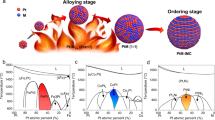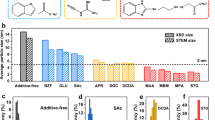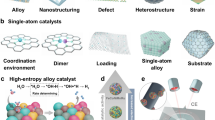Abstract
Heterostructured catalysts are essential for energy conversion and storage. However, scaling up their synthesis while maintaining precise control over diverse components is challenging. Here we introduce the difference in oxidation potential between metals and carbon as a thermodynamic factor for designing multielement heterostructures. A roll-to-roll carbothermal shock technology was developed to achieve one-step synthesis and continuous manufacturing of multielement heterostructured catalysts. A variety of heterostructured catalysts, from single elements to high-entropy alloys, oxides and their combinations, could be synthesized using this method. In addition, kinetic tunability enables precise control over elemental distributions and helps to identify distinct elemental regions to guide the fine-tailoring of heterostructured catalysts. As a proof of concept, we demonstrated rapid screening of PtCo@La–TiO2 for alkaline hydrogen evolution. Our work proposes an advanced technology for rapid synthesis, screening and continuous production of multielement heterostructured catalysts.

This is a preview of subscription content, access via your institution
Access options
Subscribe to this journal
Receive 12 digital issues and online access to articles
$119.00 per year
only $9.92 per issue
Buy this article
- Purchase on SpringerLink
- Instant access to full article PDF
Prices may be subject to local taxes which are calculated during checkout





Similar content being viewed by others
Data availability
All the data supporting the conclusions of this study are available within the Article and its Supplementary Information. Source data are provided with this paper.
References
Yuan, W. et al. In situ manipulation of the active Au–TiO2 interface with atomic precision during CO oxidation. Science 371, 517–521 (2021).
Cargnello, M. et al. Exceptional activity for methane combustion over modular Pd@CeO2 subunits on functionalized Al2O3. Science 337, 713–717 (2012).
Erisman, J. W. et al. How a century of ammonia synthesis changed the world. Nat. Geosci. 1, 636–639 (2008).
Beck, A. et al. The dynamics of overlayer formation on catalyst nanoparticles and strong metal–support interaction. Nat. Commun. 11, 3220 (2020).
Frey, H. et al. Dynamic interplay between metal nanoparticles and oxide support under redox conditions. Science 376, 982–987 (2022).
Monai, M. et al. Restructuring of titanium oxide overlayers over nickel nanoparticles during catalysis. Science 380, 644–651 (2023).
Deng, D. et al. Catalysis with two-dimensional materials and their heterostructures. Nat. Nanotechnol. 11, 218–230 (2016).
Zhao, G. et al. Heterostructures for electrochemical hydrogen evolution reaction: a review. Adv. Funct. Mater. 28, 1803291 (2018).
Kumar, A. et al. Strong metal–support interactions enhance the activity and durability of platinum supported on tantalum-modified titanium dioxide electrocatalysts. ACS Catal. 4, 1516–1525 (2014).
Nong, S. et al. Well-dispersed ruthenium in mesoporous crystal TiO2 as an advanced electrocatalyst for hydrogen evolution reaction. J. Am. Chem. Soc. 140, 5719–5727 (2018).
Song, S. et al. A selective Au–ZnO/TiO2 hybrid photocatalyst for oxidative coupling of methane to ethane with dioxygen. Nat. Catal. 4, 1032–1042 (2021).
Vincent, J. L. et al. Atomic level fluxional behavior and activity of CeO2-supported Pt catalysts for CO oxidation. Nat. Commun. 12, 5789 (2021).
Xing, F. et al. Ternary platinum–cobalt–indium nanoalloy on ceria as a highly efficient catalyst for the oxidative dehydrogenation of propane using CO2. Nat.Catal. 5, 55–65 (2022).
Yang, X. et al. Constructing oxygen vacancies via engineering heterostructured Fe3C/Fe3O4 catalysts for electrochemical ammonia synthesis. Angew. Chem. Int. Ed. 62, e202304797 (2023).
Yuan, M. et al. Unveiling electrochemical urea synthesis by co-activation of CO2 and N2 with Mott–Schottky heterostructure catalysts. Angew. Chem. Int. Ed. 60, 10910–10918 (2021).
Zhang, Z.-S. et al. Intrinsically active surface in a Pt/γ-Mo2N catalyst for the water–gas shift reaction: molybdenum nitride or molybdenum oxide? J. Am. Chem. Soc. 142, 13362–13371 (2020).
Yao, Y. et al. Carbothermal shock synthesis of high-entropy-alloy nanoparticles. Science 359, 1489–1494 (2018).
Cao, G. et al. Liquid metal for high-entropy alloy nanoparticles synthesis. Nature 619, 73–77 (2023).
Yao, Y. et al. High-entropy nanoparticles: synthesis–structure–property relationships and data-driven discovery. Science 376, eabn3103 (2022).
Mei, Y. et al. MoZn-based high entropy alloy catalysts enabled dual activation and stabilization in alkaline oxygen evolution. Sci. Adv. 10, eadq6758 (2024).
Shi, W. et al. Heterostructure engineering in high-entropy alloy catalysts. SusMat https://doi.org/10.1002/sus2.261 (2024).
Li, T. et al. Denary oxide nanoparticles as highly stable catalysts for methane combustion. Nat. Catal. 4, 62–70 (2021).
Shi, W. et al. Transient and general synthesis of high-density and ultrasmall nanoparticles on two-dimensional porous carbon via coordinated carbothermal shock. Nat. Commun. 14, 2294 (2023).
Yao, Y. et al. Computationally aided, entropy-driven synthesis of highly efficient and durable multi-elemental alloy catalysts. Sci. Adv. 6, eaaz0510 (2020).
Shi, W. et al. High-entropy alloy stabilized and activated Pt clusters for highly efficient electrocatalysis. SusMat 2, 186–196 (2022).
Sun, H. et al. Bixbyite-type Ln2O3 as promoters of metallic Ni for alkaline electrocatalytic hydrogen evolution. Nat. Commun. 13, 3857 (2022).
Shen, F. et al. Oxophilic Ce single atoms-triggered active sites reverse for superior alkaline hydrogen evolution. Nat. Commun. 15, 448 (2024).
Zhou, K. L. et al. Platinum single-atom catalyst coupled with transition metal/metal oxide heterostructure for accelerating alkaline hydrogen evolution reaction. Nat. Commun. 12, 3783 (2021).
Wan, C. et al. Amorphous nickel hydroxide shell tailors local chemical environment on platinum surface for alkaline hydrogen evolution reaction. Nat. Mater. 22, 1022–1029 (2023).
Zhou, S. et al. Boosting hydrogen evolution reaction by phase engineering and phosphorus doping on Ru/P–TiO2. Angew. Chem. Int. 61, e202212196 (2022).
Li, R. et al. New TiO2-based oxide for catalyzing alkaline hydrogen evolution reaction with noble metal-like performance. Small Methods 5, 2100246 (2021).
Kim, J. et al. Tailoring binding abilities by incorporating oxophilic transition metals on 3D nanostructured Ni arrays for accelerated alkaline hydrogen evolution reaction. J. Am. Chem. Soc. 143, 1399–1408 (2021).
Hu, S. et al. Sabatier principle of metal–support interaction for design of ultrastable metal nanocatalysts. Science 374, 1360–1365 (2021).
Vogt, C. et al. The concept of active site in heterogeneous catalysis. Nat. Rev. Chem. 6, 89–111 (2022).
Liu, S. et al. Extreme environmental thermal shock induced dislocation-rich Pt nanoparticles boosting hydrogen evolution reaction. Adv. Mater. 34, 2106973 (2022).
Chen, L.-N. et al. Ru nanoparticles supported on partially reduced TiO2 as highly efficient catalyst for hydrogen evolution. Nano Energy 88, 106211 (2021).
Kim, H. et al. Effect of hydrogen spillover on the Ru/TiO2-catalyzed guaiacol hydrodeoxygenation: rutile vs anatase TiO2. ACS Catal. 13, 11857–11870 (2023).
Li, Z. et al. Oxygen-deficient TiO2 yolk–shell spheres for enhanced lithium storage properties. Energy Environ. Mater. 5, 238–244 (2022).
Han, B. et al. Strong metal–support interactions between Pt single atoms and TiO2. Angew. Chem. Int. Ed. 59, 11824–11829 (2020).
Chong, L. et al. La- and Mn-doped cobalt spinel oxygen evolution catalyst for proton exchange membrane electrolysis. Science 380, 609–616 (2023).
Mao, Y. et al. Unravelling the synergy between oxygen vacancies and oxygen substitution in BiO2−x for efficient molecular-oxygen activation. Angew. Chem. Int. Ed. 59, 3685–3690 (2020).
Wu, Z. et al. Microwave synthesis of Pt clusters on black TiO2 with abundant oxygen vacancies for efficient acidic electrocatalytic hydrogen evolution. Angew. Chem. Int. Ed. 62, e202300406 (2023).
Lin, Z. et al. Reversed spillover effect activated by Pt atom dimers boosts alkaline hydrogen evolution reaction. Adv. Funct. Mater. 33, 2307510 (2023).
Lu, Z. et al. Ultrahigh hydrogen evolution performance of under-water ‘superaerophobic’ MoS2 nanostructured electrodes. Adv. Mater. 26, 2683–2687 (2014).
Zhou, J. et al. Electrochemically accessing ultrathin Co (oxy)-hydroxide nanosheets and operando identifying their active phase for the oxygen evolution reaction. Energy Environ. Sci. 12, 739–746 (2019).
Pan, Y. et al. Electronic structure and d-band center control engineering over M-doped CoP (M = Ni, Mn, Fe) hollow polyhedron frames for boosting hydrogen production. Nano Energy 56, 411–419 (2019).
Wei, Z.-W. et al. Reversed charge transfer and enhanced hydrogen spillover in platinum nanoclusters anchored on titanium oxide with rich oxygen vacancies boost hydrogen evolution reaction. Angew. Chem. Int. Ed. 60, 16622–16627 (2021).
Zheng, Y. et al. High electrocatalytic hydrogen evolution activity of an anomalous ruthenium catalyst. J. Am. Chem. Soc. 138, 16174–16181 (2016).
Li, G. et al. The synergistic effect of Hf–O–Ru bonds and oxygen vacancies in Ru/HfO2 for enhanced hydrogen evolution. Nat. Commun. 13, 1270 (2022).
Jiang, X. et al. The heterostructure of Ru2P/WO3/NPC synergistically promotes H2O dissociation for improved hydrogen evolution. Angew. Chem. Int. Ed. 60, 4110–4116 (2021).
He, Q. et al. Achieving efficient alkaline hydrogen evolution reaction over a Ni5P4 catalyst incorporating single-atomic Ru sites. Adv. Mater. 32, 1906972 (2020).
Hasegawa, M. in Treatise on Process Metallurgy (ed. Seetharaman, S.) Ch. 3.3 (Elsevier, 2014).
Weimer, A. W. et al. Kinetics of carbothermal reduction synthesis of beta silicon carbide. AIChE J. 39, 493–503 (1993).
Reed, T. B. Free Energy of Formation of Binary Compounds (MIT Press, 1971).
Acknowledgements
This work is supported by the National Key R&D Program of China (grant no. 2021YFA1202300), the National Natural Science Foundation of China (grant nos. 22325901, 52371223, 52401280, 52101255 and 52272046), the Beijing National Laboratory for Molecular Sciences (BNLMS202405) and the Fundamental Research Funds for the Central Universities of HUST (grant nos. 2023JCYJ004 and YCJJ20242227). Y.S. acknowledges the ‘Young Talent Support Plan’ of Xi’an Jiaotong University. Supercomputing facilities were provided by Hefei Advanced Computing Center. We thank the test support from the Analytical and Testing Center of Huazhong University of Science and Technology, the State Key Laboratory of Materials Processing, and Die and Mould Technology.
Author information
Authors and Affiliations
Contributions
Y.Y. and B.Y.X. conceived and designed the project. W.S. synthesized the materials. W.S., H.L., H.Z., L.Z. and K.Y. carried out the electrochemical testing. W.S., Zihui Liang, J.Z., B.Y.X. and Y.Y. contributed to the characterization and related discussion. W.S., F.T., Y.L. and Zihui Liang performed the contact angle measurements. Y.S. and S.S. contributed to the theoretical calculations. J.Z., Y.W, Y.G., D.S. and Zhiqiang Liang. contributed to the STEM measurements. Y.L. designed the roll-to-roll equipment. W.S., H.L., Y.H., B.Y.X. and Y.Y. cowrote and revised the paper. All the authors discussed the results.
Corresponding authors
Ethics declarations
Competing interests
The authors declare no competing interests.
Peer review
Peer review information
Nature Synthesis thanks the anonymous reviewers for their contribution to the peer review of this work. Primary Handling Editor: Alexandra Groves, in collaboration with the Nature Synthesis team.
Additional information
Publisher’s note Springer Nature remains neutral with regard to jurisdictional claims in published maps and institutional affiliations.
Supplementary information
Supplementary Information
Supplementary Figs. 1–59 and Tables 1–7, and references.
Supplementary Movie 1
The roll-to-roll CTS process.
Supplementary Movie 2
The contact angle test of Pt/C electrode under-electrolyte.
Supplementary Movie 3
The contact angle test of Pt electrode under-electrolyte.
Supplementary Movie 4
The contact angle test of PtCo@TiO2 electrode under-electrolyte.
Supplementary Movie 5
The contact angle test of PtCo@La–TiO2 electrode under-electrolyte.
Source data
Source Data Fig. 1
Statistical source data.
Source Data Fig. 2
Statistical source data.
Source Data Fig. 3
Statistical source data.
Source Data Fig. 5
Statistical source data.
Rights and permissions
Springer Nature or its licensor (e.g. a society or other partner) holds exclusive rights to this article under a publishing agreement with the author(s) or other rightsholder(s); author self-archiving of the accepted manuscript version of this article is solely governed by the terms of such publishing agreement and applicable law.
About this article
Cite this article
Shi, W., Liu, H., Zhang, J. et al. Roll-to-roll synthesis of multielement heterostructured catalysts. Nat. Synth 4, 836–847 (2025). https://doi.org/10.1038/s44160-025-00758-y
Received:
Accepted:
Published:
Issue date:
DOI: https://doi.org/10.1038/s44160-025-00758-y



